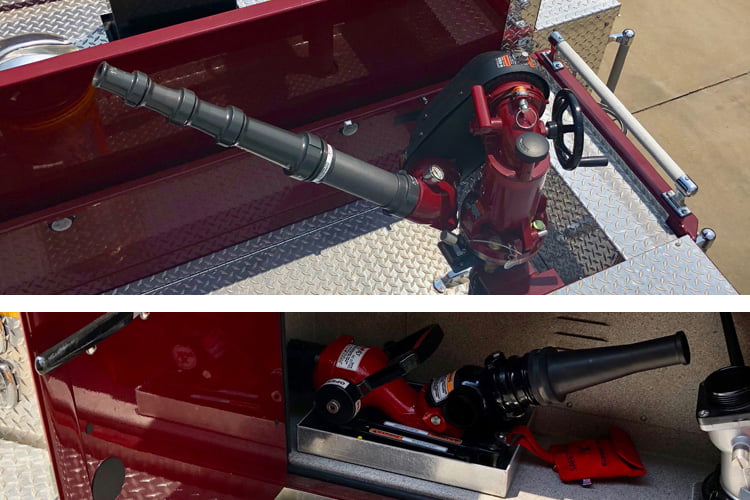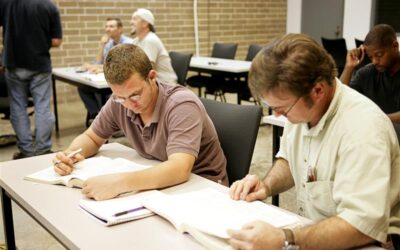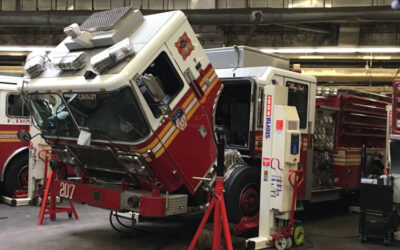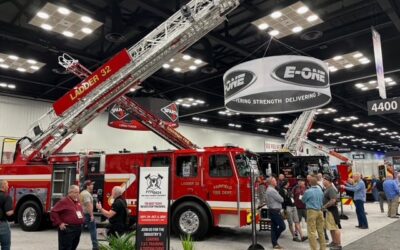By Ricky Riley
During recent purchases of new apparatus, we took a look at how we can deploy master stream devices off our new engines. What seems to be a growing unfortunate trend in the fire service is the alarming number of large fires in buildings under construction or in structures nearing completion. These fires require departments to discharge large amounts of water on these fast growing and fast-moving fires. We wanted to make sure that our engine companies can deliver this punch at these fires with good flows and with the thought that getting ahead of the fires quickly would also be needed.
In looking at the current setup, we have a top-mount deck gun/deluge monitor in the dunnage area above the fire pump. This is supplied by a three-inch pipe to a flange that the deck gun is mounted too. The flange allows crews to remove the deck gun in case we want to make the device mobile. One of the options we chose for our top-mounted deck gun was to locate the pipe and device close to the side of the apparatus over top of the pump panel. That way the operator can easily climb up the side of the apparatus and position the deck gun for operation without actually having to climb all the way up on top of the apparatus—hopefully saving time in starting the operation and not having the driver/operator doing more up-and-down climbing in the process.
Flowing the master stream from a different location than the top of the apparatus takes two people to safely accomplish. Taking the deck gun off the flange and then getting it down from the apparatus can be a challenge for any department. The weight of the gun and how we have the climbing areas on the side of the apparatus can make this challenging and sometimes dangerous for the personnel assigned this task. Then, where is the portable stand for the deck gun? This portable stand is a beast in itself, and depending on where it is stored can cause issues in retrieving it from the rig and deploying.
What size lines we use to supply these portable deck guns is a department decision. They can use two three-inch lines or a four- or five-inch supply line, all of which are pretty standard for departments. And after we hook these lines up and start flowing, we can usually get a good flow from the device. But if we have to move this device for any reason, how difficult does that become? Especially when having to extend the large-diameter lines or both three-inch lines? When it comes to moving these devices, mobility is not truly and option.
In our thought process we identified that the top deck gun should probably stay right there on top of the apparatus. We decided to purchase one of the smaller and more mobile master stream devices to store in a lower compartment on the apparatus in addition to our deck gun. There are a number of different manufacturers for these devices, and it is up to your specific likes and specification demands to determine what your department might need. These devices allow for departments with limited staffing to rapidly deploy a large-caliber stream quickly and efficiently and to achieve great flow numbers depending on the nozzle and what the supply is. We chose a device with a single 2½-inch coupling to allow the use of 2½- or three-inch hose to supply the device. The device itself can flow 500 gpm from a single line. And, the design of these devices allows for right and left sweeping along with an easy up and down motion—much like operating a handline.
This choice has given us the ability to rapidly deploy and easily maneuver a large-flow device that can keep ahead of the fires we talked about at the beginning of the article, which is unlike the top mounted portable deck gun configuration. By making these decisions, we believe that we have given firefighters a number of options for fire attack that can produce large-caliber streams in an efficient and safe manner. Regardless of our decision or your department’s decision on how you are going to deploy these high-gpm devices, it all goes back to training, training, and training. All the best purchases and plans in any department are worthless without firefighters being well-trained and efficient and practiced in their deployment and operation. So, take advantage of the great upcoming summer months to get out and practice with your large-flow devices.
Thanks again for taking the time to read the latest installment of The Rig.
RICKY RILEY is the fire apparatus manager for the Prince George’s County (MD) Fire/EMS Department. He previously served as the Operations Chief for Clearwater (FL) Fire and Rescue, and as a firefighter for Fairfax County (VA) Fire & Rescue. He also currently serves as the rescue-engine captain at the Kentland (MD) Volunteer Fire Department. He is a member of the editorial advisory board of Fire Apparatus & Emergency Equipment.






